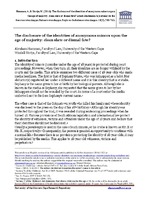| dc.identifier.citation | Hamman, A., & Nortje, W. (2016). The disclosure of the identities of anonymous minors upon the age of majority: clean slate or dismal fate? Litnet Akademies:'n Joernaal vir die Geesteswetenskappe, Natuurwetenskappe, Regte en Godsdienswetenskappe, 13(2), 730-752. | en_US |
| dc.description.abstract | The identity of minors (juveniles under the age of 18 years) is protected during court proceedings. However, when they turn 18, their identities are no longer withheld by the courts and the media. This article examines two different cases of 18-year-olds who made media headlines. The first is that of Zephany Nurse, who was kidnapped as a baby. Her abductor(s) registered her under a different name and it is this identity that is at stake. Zephany is the name given to her at birth by her biological parents. Although she is known in the media as Zephany, she requested that the name given to her by her kidnappers should not be revealed by the court. In terms of a court order the media undertook not to disclose Zephany's current name. The other case is that of the Griquatown youth who killed his family and whose identity was disclosed to the press on the day of his 18th birthday. Although his identity was protected throughout the trial, it was revealed during sentencing proceedings when he turned 18. Various provisions of South African legislation and international law protect the identity of witnesses, victims and offenders under the age of 18 years and declare that their identities should not be disclosed. Usually a pseudonym is used in the case of such minors, or he or she is known as Mr. X or Ms. X, respectively. Consequently, the person is granted an opportunity to continue with a normal life. Because there is no provision protecting the identity of 18-year-olds, it may be published by the media. This applies to 18-year-old witnesses, victims and perpetrators. The primary aim of this contribution is to determine whether or not the identity of anonymous minor witnesses, victims and perpetrators should be published upon their reaching the age of 18. A further issue is whether a convicted 18-year-old offender should be treated the same as witnesses and victims or whether victims and witnesses have a stronger claim to the protection of their identity. This discussion also refers to an English case involving a minor, James Bulger, who was brutally killed, and analyses how the courts dealt with the publication of the identity of the juvenile offenders when they turned 18. Moreover, the international position is examined, as well as the South African legislation regarding the position of witnesses, victims and offenders. The article concludes with a recommendation as to how future legislation could deal with the situation. | en_US |

